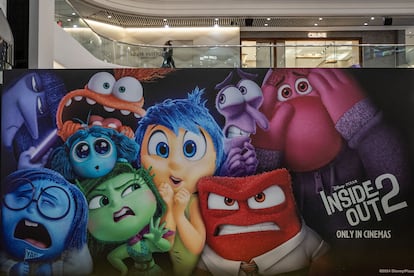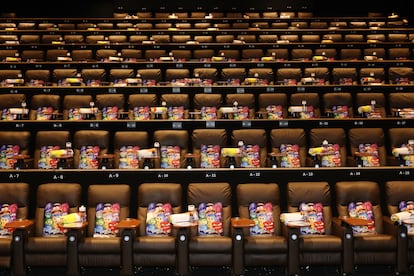The problem with ‘Inside Out 2:’ Are our emotions at the service of productivity?
Disney’s sequel to its box-office smash, despite mixed reviews, has quickly become the year’s biggest hit. Its notion of the human brain as factory, nonetheless, feels controversial


Having racked up more than $1 billion in revenue since its release a few weeks ago, Inside Out 2, Pixar’s follow-up to its 2015 hit, is already the best-selling movie of the year. While its first installment focused on the mental landscape of a little girl, Riley, portraying it as a factory in which her emotions (Joy, Sadness, Anger, Disgust, Fear, which take the form of fantastical creatures) had to work as a team, the second film catches up with the protagonist, now a teenager, a crucial phase in which, in this narrative, new emotions make their appearance: Anxiety, Embarrassment, Envy, Ennui — this last one, a kind of cross between boredom and apathy. Although the film has proved to be an economic lifeline for the Disney-owned studio after Lightyear (2022) and Elemental (2023) were released to more muted results, critics have not been as enthusiastic about Inside Out 2 as they were about the original, largely due to a copycat plot that provides few surprises.
“Inside Out 2 almost feels like a downloadable-content add-on for the first Inside Out, rather than a story of its own,” writes journalist Jay Caspian Kang in a New Yorker column. He continues, writing that it “suggests that there will be more content add-ons to come… Perhaps in Inside Out 8 we will become acquainted with the 44-year-old Riley and meet the four newest emotions who run her life: Dysthymia, Indifference, Displaced Anger, and Rationalized Disappointment.” His fellow New Yorker critic Richard Brody was one of the few dissenting voices upon the release of the original film, of which he wrote: “I saw a feature-length sales pitch — or, worse, an indoctrination — to mold kids into beings as artificial and uniform as those created by computer graphics. (…) In lieu of the mysteries and wonders of life, instead of big dreams and big fears, Inside Out offers problems to be solved, a narrow life of narrow prospects and narrow experiences, narrow fantasies and narrow desires.”
Inside Out 2 is part of the studio’s new business strategy, which the company’s chief creative officer Pete Docter explained in a polemic interview published by Bloomberg last May: “Studio features should be less about a director’s search for catharsis and more about talking about a common experience,” an apparent allusion to more personal films like Luca (2021), Red (2022) and Elemental, all made by directors who are immigrants or recent descendants of immigrants, with elements of their cultures integrated into the animation. Docter, who did not return for the sequel, was the director of the first installment of Inside Out, as well as other massive hits from the studio’s golden age like Monsters, Inc. (2001) and Up (2009). The former film, about oogie-boogies who get energy from scaring children, shares its corporate focus with Inside Out, similar to Docter’s last project, Soul (2020), in which the Great Beyond is an industrial operation and souls are allowed to be born on Earth only after they complete professional training.

In the two volumes from his series of books entitled La otra Disney (The Other Disney; 2020-’23, Applehead Team), cultural critic Alberto Corona analyzed the lineage of live-action films developed by the studio since the 1940s, traveling from business strategy to social context and ideological discourse that permeated Disney’s projects throughout the last century. At the end of the second volume, the journalist speaks of Disney’s transformation into the great entertainment conglomerate it is today after buying Pixar in 2006, Marvel in 2009, Lucasfilm (which holds the rights to Star Wars and Indiana Jones) in 2012 and Fox in 2019. Although Corona believes that this has led to an esthetic homogenization among Disney’s different properties, with “modes of production associated with the images of amusement parks and their showcases,” he also thinks that the chaos of Pixar deserves to be analyzed as a separate phenomenon. In a piece for elDiario.es, he notes the studio’s tendency to set its stories in “corporate settings.”
“The certain decline of Pixar is blamed on its becoming part of Disney, including its tendency towards many more sequels, but the ideology that Pixar brought with it fits very well within the Disney of late-stage capitalism,” Corona tells EL PAÍS. “It was born in the late 1980s in the context of a new ideology of capital, that of Silicon Valley, with that corporate thing about how cool the company is and ‘we’re one big happy family’ while maintaining individual distinction. There we have the figure of Steve Jobs [who was a major shareholder in the company]. If Pixar has been anxious to place its characters in companies, to conceive of every possible imaginary, every visible aspect of life, as something wonderful and exhilarating and set in an office, I think that’s why. Inside Out is the height of this way of thinking, because it’s our very emotions that get the treatment.”
What seems to prove Docter right about the universal accessibility of Inside Out, apart from the configuration of its imaginary world, has been its audience reaction. Beyond box office figures, the sequel has also led many viewers to share on social media about the experience they had watching the film and the intimate way in which they connected with its representations of anxiety. Leticia Porto Pedrosa, PhD in communication sciences and sociology from the Complutense University of Madrid, who has published several theses on social models presented in animated films, emphasizes that the film, “marks an interesting final reflection on the importance of taking care of mental health during adolescence to lead a full life in the future.”

The academic’s doctoral thesis echoes parts of Ariel Dorfmann and Armand Mattleart’s classic 1971 book-length essay How to Read Donald Duck on Disney’s political messaging, though she thinks that “[the studio’s] values and messages have adapted throughout the times.” “In its moment, it was a revolution to introduce new princesses to the Disney repertoire like Mulan (1998), Tiana (from The Princess and the Frog, 2009) and Brave (2012). “Social structures and models that are disseminated respond to social demands and new realities,” Porto Pedrosa tells EL PAÍS, adding that, “Pixar movies are full of wonderful lessons that are not often taught by the family or at school.”
In this sense, Corona says that, “the explosion of mental health as a kind of fetish in public discourse took place prior to Inside Out.” “It wouldn’t be unreasonable to say that it was a bit of a precursor to this idea of assuming that sadness is a part of life, which is not a bad way of thinking,” the critic says. “I don’t think it’s cynical to approach mental health and give children an explanation that can serve them in their day-to-day lives.”
Let’s get to work, emotions
In the book Disney, Culture and Curriculum (2016, Routledge), author Jake Burdick directly links seminal Disney shorts like Steamboat Willie (1928) and Three Little Pigs (1933) with the productions Pixar is now making. “Inside Out continues to evoke values that coincide with the logic of productivity and that of the worker, just like its fixation on childhood as a lost object, traumatic but necessarily located within the world of work. (…) As long as harmony is achieved within their kind of psychic factory, all emotions become more productive, joyful and satisfied in their work,” writes Burdick, who, despite the “affective turn” he believes the studio has recently taken, refers to its recent efforts as “reinventions of Fordist fantasies for contemporary sensibilities.” However, the notion of emotions at work was by no means invented by Disney or Pixar.
Marxist author Eva Illouz, who studies, among other subjects, the role of psychology in the formation of modern identity, proposed a concept of “emotional capitalism” in the first decade of the 21st century to talk about the modern co-production of the economy and emotions. María Tocino Rivas, who has her doctorate in philosophy from the University of Salamanca, and who published El capitalismo emocional. De Eva Illouz a los teóricos del biocapitalismo (Emotional capitalism. From Eva Illouz to biocapitalism theories, Dykinson) last year, sees Inside Out as “a clear expression of what we experience as and that Eva Illouz calls therapeutic culture, in which the categories of clinical psychology permeate the collective imaginary.” “One of the characteristics of this therapeutic culture, and of the emotional capitalism paradigm of which it forms part, is that which Illouz calls the rationalization of emotional life, a process of objectification of emotional states and processes, which links to the introduction of economic logic in its subjects’ intimate lives,” the professor tells EL PAÍS.
“The ideal of emotional management forms part of this paradigm,” she says. “Though it has to do with a multi-causal phenomenon, one factor that explains the spreading of therapeutic culture has to do with the appearance, in neoliberal capitalism, of labor models that call for a permanent management of the self. This is due to the fact that, as found by biocapitalism theorists, work is involving more and more aspects of interpersonal relationships, production and management of immaterial goods and the use of new technologies. It’s getting more and more difficult to separate work from life, and emotional management becomes essential. Likewise, these new labor models generate psychiatric maladies linked to precariousness, instability and the difficulty of keeping personal life separate from work. Anxiety is one of the primary manifestations of this, and that’s why it takes on so much importance in the second Inside Out movie.”
Still, the author believes that, “this therapeutic culture of which Inside Out is an expression” can positively contribute towards “depathologizing mental health problems and to spreading practices related to the relief of psychiatric illness.” Tocino Rivas brings up Marta Carmona and Javier Padilla’s book Malestamos: Cuando estar mal es un problema colectivo (We’re sick: When unwellness is a collective problem, 2022) as a reminder that “it’s essential for therapy to be accompanied by a structural approach to the socio-historical problems that cause unwellness.” Journalist Alberto Corona sees the primary problem with the Inside Out films as being their portrait of mental health, “as something apart from society. Riley’s entire crisis is solved by her emotions learning to organize themselves better, when what is really happening is that she’s leaving her friends behind to become part of a new group, which could be solved by having a conversation with the others,” the author of The Other Disney tells EL PAÍS.
Corona praises Red, the Pixar film that was released straight to Disney+ and that focuses on a young women’s transition into adolescence as a contrasting and superior model, in which the protagonist grows up, “having friends, going to concerts and learning about her parents,” and is not solely based on internal mental processes, like those that drive, up to this point, the two Inside Out films. “In the end, those are the things that make us think about therapy not as a way of adjusting to the world’s circumstances, but as something we must cook up and eat on our own. You’ve got problems? Don’t talk to people, much better to go to a psychologist.”
Translated by Caitlin Donohue.
Sign up for our weekly newsletter to get more English-language news coverage from EL PAÍS USA Edition
Tu suscripción se está usando en otro dispositivo
¿Quieres añadir otro usuario a tu suscripción?
Si continúas leyendo en este dispositivo, no se podrá leer en el otro.
FlechaTu suscripción se está usando en otro dispositivo y solo puedes acceder a EL PAÍS desde un dispositivo a la vez.
Si quieres compartir tu cuenta, cambia tu suscripción a la modalidad Premium, así podrás añadir otro usuario. Cada uno accederá con su propia cuenta de email, lo que os permitirá personalizar vuestra experiencia en EL PAÍS.
¿Tienes una suscripción de empresa? Accede aquí para contratar más cuentas.
En el caso de no saber quién está usando tu cuenta, te recomendamos cambiar tu contraseña aquí.
Si decides continuar compartiendo tu cuenta, este mensaje se mostrará en tu dispositivo y en el de la otra persona que está usando tu cuenta de forma indefinida, afectando a tu experiencia de lectura. Puedes consultar aquí los términos y condiciones de la suscripción digital.
Archived In
Últimas noticias
Millennia-old Yuracaré language resists extinction through 900 speakers and a new dictionary
Susan Boyle prepares a comeback just as Timothée Chalamet sings her praises
Trump suspends green card visa lottery after shooting at Brown University
When things get out of hand at the lab: Hundreds of accidents expose the ‘catastrophic’ risk of dangerous pathogen leaks
Most viewed
- Christian Louboutin: ‘Young people don’t want to be like their parents. And if their parents wear sneakers, they’re going to look for something else’
- Cartels in Mexico take a leap forward with narco-drones: ‘It is criminal groups that are leading the innovation race’
- Liset Menéndez de la Prida, neuroscientist: ‘It’s not normal to constantly seek pleasure; it’s important to be bored, to be calm’
- ‘El Limones’ and the growing union disguise of Mexican organized crime
- The low-cost creative revolution: How technology is making art accessible to everyone








































